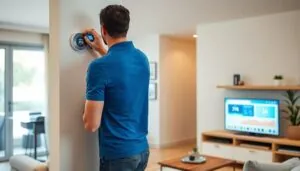In today’s tech-savvy world, smart homes promise a lifestyle straight out of a sci-fi movie. Imagine controlling your lights, thermostat, and even your coffee maker with just a voice command. Sounds dreamy, right? But before you start picturing yourself as the next tech guru, it’s essential to recognize the challenges lurking behind those sleek devices.
From compatibility issues that make your gadgets act like they’re in a soap opera to security risks that could turn your home into a hacker’s playground, the road to a fully automated home isn’t always smooth. Navigating these hurdles can feel like trying to teach a cat to fetch. So, let’s dive into the quirky yet crucial challenges of smart home technology and discover how to turn those potential pitfalls into stepping stones for a smarter, safer living space.
Table of Contents
ToggleOverview of Smart Home Challenges
Smart home technology faces several significant challenges that can affect user experience and security. Device compatibility ranks high among these issues. Various brands and platforms often do not integrate seamlessly, causing frustration for users trying to create a cohesive smart home system.
Security vulnerabilities present another critical concern. Hackers increasingly target connected devices, exploiting weaknesses that can lead to unauthorized access. Data breaches can compromise personal information and privacy, alarming users regarding the safety of their homes.
Network reliability also plays a vital role in smart home functionality. A stable internet connection is essential for device communication and operation. Interruptions can disrupt control of appliances, lighting, and security systems, leading to a less efficient living environment.
User experience, particularly concerning installation and usability, poses additional challenges. Some devices require technical knowledge to set up, resulting in a steep learning curve for less tech-savvy individuals. Complicated interfaces can deter widespread adoption of smart home technology.
Cost barriers hinder many potential users from entering the smart home market. Smart devices often come with premium price tags that may not align with everyone’s budget. As a result, investing in multiple devices can accumulate significant expenses, limiting accessibility to smart home solutions.
Awareness and education about products also contribute to the challenges. Many consumers remain unaware of the full range of smart home technologies available. Misinformation or lack of information can hinder informed decision-making and adoption.
Addressing these challenges involves understanding the risks and implementing strategic solutions to create a harmonious and secure smart home environment. Focusing on compatibility, security, network reliability, user experience, cost, and education serves as a foundation for overcoming these hurdles.
Technical Challenges

Smart homes face several technical challenges that can hinder their overall effectiveness. Two primary issues are connectivity and device compatibility.
Connectivity Issues
Connectivity issues significantly impact smart home reliability. Wi-Fi networks often suffer from interference, leading to dropped connections. Devices may disconnect during critical moments, leaving users unable to control appliances. Obstacles include walls and distance from the router, which can weaken signals. Solutions involve strategically placing routers or using Wi-Fi extenders to improve coverage. Stable connections are essential for seamless operation and security feature effectiveness.
Device Compatibility
Device compatibility remains a major hurdle for smart home users. Different brands may use proprietary protocols, resulting in integration challenges. Frustration can arise when attempting to connect devices from multiple manufacturers. Some platforms do not support certain devices, restricting users’ options. Standards like Matter aim to improve compatibility across brands, allowing users to enjoy a more unified experience. Ensuring devices work together effectively enhances the overall smart home experience.
Security and Privacy Concerns
Smart homes offer convenience but pose significant security and privacy challenges. Users face increasing risks of data breaches and unauthorized access to personal information.
Data Vulnerability
Connected devices often collect sensitive information, making them potential targets for cybercriminals. Households using smart appliances saw an uptick in incidents where hackers accessed cameras and personal data. Research indicates that nearly 70% of connected devices exhibit security weaknesses. Manufacturers may prioritize convenience over security, creating risks that extend to the entire network. Implementing strong passwords and regular software updates significantly enhances security against breaches.
User Trust Issues
Trust in smart home technology has waned due to privacy concerns. Many users feel uneasy about how companies utilize collected data. A survey found that over 60% of individuals worry about their data being sold to third parties. Recognizing this, companies need to provide transparent privacy policies. Users prefer devices that clearly state data usage and storage methods. Building trust requires commitment from manufacturers to ensure user data remains protected.
Usability Challenges
Smart home technology presents usability challenges that can impact user experience. Navigating through various interfaces and aligning multiple devices often poses significant hurdles for users.
Complexity for Users
Devices often come with intricate setups that can overwhelm users, particularly those unfamiliar with technology. Complicated installation processes can lead to frustration, discouraging users from fully utilizing smart home capabilities. Additionally, multiple apps for different devices complicate management. Streamlining the interface and providing easy-to-follow instructions can boost user confidence. Solutions like centralized control systems can simplify interactions and enhance the overall experience. Developers need to prioritize user-friendly designs to engage a broader audience effectively.
Accessibility for Seniors
Smart home devices frequently pose challenges for seniors, making accessibility a primary concern. Small fonts and intricate menus can hinder their interaction with technology. Many seniors might lack the technical skills needed to navigate multiple device settings. Offering voice-activated controls and simplified interfaces can bridge the gap. Engaging caregivers or family to assist in setup significantly eases the transition. Manufacturers should consider these factors and develop solutions that cater to the unique needs of older adults, enhancing their independence and comfort within a smart home environment.
Economic Considerations
Smart home technology presents several economic challenges, particularly related to implementation and ongoing maintenance. Understanding these factors is vital for consumers looking to adopt this advanced technology.
Cost of Implementation
Initial investment ranks high among economic considerations. Smart devices vary in price, with some models exceeding $500 each. Comprehensive systems, including smart hubs or extensive installations, may cost thousands. Additionally, integration of multiple devices can complicate budgeting, as consumers often face unexpected expenses during setup. Finding affordable solutions requires careful research and comparison across brands. Discounts during seasonal sales offer potential savings yet may not occur regularly. Therefore, proper planning remains essential to manage expenses effectively.
Maintenance and Upgrades
Ongoing maintenance costs further challenge smart home sustainability. Manufacturers release frequent updates to improve functionality and security, typically requiring users to manage these updates manually or periodically replace devices. Some systems become obsolete quickly, necessitating upgrades to maintain compatibility with new technologies. Regular security assessments help protect against potential breaches, but they may incur additional costs. Investing time in research remains crucial to finding cost-effective options for maintaining smart home systems. Prioritizing quality also ensures durability, reducing the need for frequent replacements.
Navigating the complexities of smart home technology requires awareness and proactive measures. Users must stay informed about compatibility issues and prioritize security to safeguard their connected devices. Embracing user-friendly designs can enhance the experience for everyone, especially seniors and those less familiar with technology.
Investing in reliable network solutions and understanding the economic implications of smart home systems will ensure a smoother transition to a more connected lifestyle. As the industry evolves, addressing these challenges will pave the way for a more secure and efficient smart home environment that meets the needs of all users.


